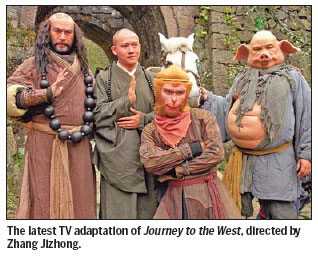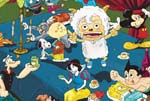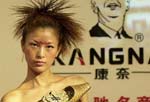Movie
Leaping from printed page to silver screen
Updated: 2011-03-30 07:52
By Sun Li (China Daily)

Outlaws of the Marsh
The Water Margin, 1972
The Shaw Brothers' kungfu extravaganza concentrates on the Liangshan Mountain heroes' rescue attempt of the "Jade Dragon" Lu Junyi. He is sentenced to death due to a libellous suggestion that his collaboration with the outlaws helped them kill Shi Wengong, who murdered the gang's leader.
The first film, by Hong Kong movie maestro Chang Cheh, which adapted Shi Nai'an's sprawling novel, features Chang's trademark blood-spattering swordplay, drawing together the bulk of the studio's top stars and a couple of Japan's A-listers for the lead roles.
All Men Are Brothers, 1975
A sequel to The Water Margin, Chang Cheh's second cinematic adaptation of Outlaws of the Marsh revolves around the time when the Liangshan bandits are pardoned by the emperor, who orders them to assassinate Fang La, the leader of a rebellion.
Like its predecessor, the film is packed with hard-boiled action sequences, but unlike The Water Margin and many other Shaw Brothers kungfu flicks, it features some amazingly grandiose battle scenes, including a series of large-scale battles on land and a montage of an intense naval fight.
Tiger Killer, 1982
The kungfu drama centers on Wu Song (Ti Lung), one of the most famous heroes in Outlaws of the Marsh, who drinks copious amounts of alcohol before beating a man-eating tiger to death, with his bare hands, and who takes vengeance on Pan Jinlian and Ximen Qing, his elder brother's murderers.
Directed by Li Han-hsiang, this Shaw Brothers masterpiece pulls off a heart-palpitation-inducing fight scene between an actor and real tiger.
Journey to the West
Havoc in Heaven, 1965
Directed by China's pioneering Wan Laiming, the animation adapts the earliest chapters of Wu Cheng'en's 16th century classic, recounting the origin and ascension to power of Sun Wukong, the Monkey King, who comes into conflict with the Jade Emperor.
Produced by Shanghai Animation Film Studio between 1961 and 1964, the film is a lively adaptation of the Monkey King legend, featuring top-notch hand-drawn animations and a Peking Opera music score for each major scene. It was shown for the first time in China in 1965 to great acclaim and is still the country's most famous and successful animated movie, representing the golden age of Chinese animation.
Monkey Goes West, 1966
On his epic journey to retrieve Buddha's sacred scriptures, Buddhist monk Xuanzang is chased by demons that want to eat his flesh and gain immortality. But thanks to the Monkey King, a disciple, Xuanzang keeps making miraculous escapes. Helmed by Ho Meng-hua, the big-budget spectacle was the Shaw Brothers' equivalent of The Wizard of Oz (1939), showcasing the studio's most flamboyant makeup and dazzling special effects.
A Chinese Odyssey, 1994
Written and directed by Hong Kong new wave filmmaker Jeff Lau, the two-part parody offers an unusual mixture of Chinese mythology, slapstick comedy, romance and kungfu fantasy.
The first installment, Pandora's Box, follows the adventures of the Monkey King (Stephen Chow), who is reincarnated 500 years later and whose only identifying feature is three marks on the feet. Part Two, Cinderella, continues with the convoluted time traveling and details the Monkey King's relationships with various women.
Romance of the Three Kingdoms
Red Cliff, 2008
Marking John Woo's return to Chinese-language cinema after more than a decade of Hollywood productions, the sweeping war epic centers on a legendary military clash depicted in Luo Guanzhong's historic novel.
Cao Cao, the powerful prime minister and ruler of the larger army of the Eastern Han, sends an armada down the Yangtze River to attack the rulers of two smaller kingdoms, Liu Bei and Sun Quan. The crucial alliance against Cao is headed by the two leaders' strategists, Zhuge Liang (Takeshi Kaneshiro) and Zhou Yu (Tony Leung).
A stunning visual triumph, the film demonstrates some ancient battle strategies, including striking elaborate formations, which enables a smaller force to defeat its more numerous foe.
Three Kingdoms: Resurrection of the Dragon, 2008
Daniel Lee's action drama focuses on Zhao Zilong (Andy Lau), a commoner from Liu Bei's Shu kingdom, who has fantastic martial arts skills. He joins the army and is quickly promoted to become one of the Five Tiger Generals, after attaining a series of victories against Cao Cao's armies, including single-handedly rescuing the young prince from deep behind enemy lines.
In trying to tell a lifetime of stories about a legendary figure in one-and-a-half hours, the film has a few gaps, but the combination of impressive fight scenes, lavishly decorated sets and elaborate costumes create a film with visual splendor.
E-paper

Green mission
Tony blair believes China will take a leading role to fight climate change and cut emissions.
Stepping on to success
French connection
Generation gaps
Specials

Have you any wool?
The new stars of Chinese animation are edging out old childhood icons like Mickey Mouse and Hello Kitty.

Fill dad's shoes
Daughter and son are beginning to take over the family business of making shoes.

Virtual memorial
High-Tech touches to traditional tombsweeping festival help environment.
